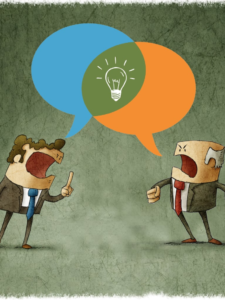 Rande Sotomayor – IAM Distinguished Fellow
Rande Sotomayor – IAM Distinguished Fellow
Most of us try to avoid conflict. It portends confrontation, is uncomfortable at best, and is horribly violent at worst. What if SOME of the conflicts you have could be productive and leave you feeling relieved? I have an idea.
Even though we try to avoid conflict, we experience it every day. Around the globe, at work, in the boardroom, among family members. Here are some tools to use to resolve conflict constructively. You may be familiar with them, but I offer a simple approach, even a handy list at the end.
Resolution can provide the relief and personal calm we all crave. You have to recognize two things: (1) try as you might, you cannot control others, and (2) you can control your own perspective, reactions, and anger.
I will tell you the four words, but not yet.
1. PEOPLE DON’T ALWAYS SEE THINGS THE WAY YOU DO
Take a look at the drawing below. It is by William Ely Hill and entitled “My Wife and My Mother-in-Law.” What do you see? Can you find the young woman? The older woman?
Look at this next picture. What do you see? A man playing a saxophone? A woman’s face?
These images are generally referred to as “ambiguous” figures. They are objects that can be seen in more than one way.
Similarly, “truth,” or what is real or fake, is a matter of perspective. Everyone has their own truth. Individuals can’t know everything, so we rely on others we trust to give us the “facts.” If the “facts” are not believable, consider asking “Why?” before passing judgment.
- YOU CAN’T LEARN ANYTHING IF YOU’RE THE ONLY ONE TALKING
You have probably heard of the term “active listening.” Most people think they are listening when in fact what they are really doing is waiting their turn to jump in and talk about their position or feelings. When we exercise active listening skills, we are listening to understand, not to respond. Active listening can be learned and practiced.
You know how easy it is for an argument to escalate into something ugly. The first step to de-escalating an inflammatory situation is to look inward. We can learn when to take a critical pause or time-out by observing our physical and emotional responses in any conflict. Awareness of these responses is your cue to take a mental or physical break and, metaphorically, “go to the balcony,” a calm place where you can pause, get yourself under control, and refocus on the real issues. Take a look at Getting to Yes with Yourself, by William Ury.
Teddy Roosevelt once said: “If you could kick the person in the pants responsible for most of your trouble, you wouldn’t sit for a month.” Is the problem really the other person?
- IMPLICIT BIAS IS A DEEP OBSTACLE
We are all biased; there is so much science behind this conclusion that it is nearly impossible to refute. While we may make noteworthy and noble efforts to dispel bias in ourselves and in our communities, we naturally defend ourselves as consciously unbiased.
Implicit bias, bias that is based on our upbringing, community values, and formative experiences, is unconscious, and thus outside our ability to control it. Implicit bias leads us to make judgments about people, often silently.
When we look inside, I think we would all admit that before we know anything at all about someone we may hear about or encounter, we would judge that person. “She looks old.” “Do you think he’s gay?” “Let’s cross the street; that Black man looks like he’s up to no good.” “She is absolutely obese; what happened to her?”
Dealing with, and eventually overcoming, implicit bias begins with awareness that it exists in all of us. With that awareness, we can become more conscious of how much our words, tone of voice, facial expressions, and body language matter.
In the meantime, each individual has a role to play. One moment, one opportunity, for one person to make a positive change – by just beginning to practice self-awareness of bias and active listening, even in a seemingly small way – can be a seed of transformation.
- HERE IS THE FOUR-WORD SOLUTION TO MOST OF YOUR CONFLICTS: REPLACE JUDGMENT WITH CURIOSITY
Everyone has secrets, burdens, fears, and insecurities, not only you. They are often the source of pain that all of us carry, often unfulfilled needs or expectations.
What are you afraid of? Financial insecurity, not being able to support your family, losing your job, losing your home, embarrassment? Perhaps even not living up to your own expectations? Are you so worried, disappointed, or ashamed that you crack and hurt those around you?
To defuse a situation for yourself, “go to the balcony” to get control and cool a hot head in order to think clearly.
Be kinder and more positive with people you assume are difficult and will pick a fight with you. Don’t expect to be attacked. Expect to be respected. Don’t put up defenses unless you need to. Just ask questions so you can understand their point of view.
- THE TAKEAWAYS
Simple rule: Use CURIOSITY to understand.
Recognize that people won’t always see things the way you do.
You can’t learn anything if you’re the only one talking.
Develop awareness of unconscious bias and be open to accepting those who disagree with you. Try first to find things you have in common, and work from there. Don’t dismiss people based on assumptions about them.
When in doubt, or if you don’t know what to say, ask a question.
If you don’t know what question to ask, simply ask “Why?”
I believe in practical ways of finding peace for myself. These are tools I use to improve my relationships and resolve conflicts I face. If you find them useful, let me know. I’d love to hear your story. Email me at rande@sotomayorlaw.com



